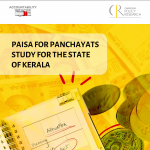
What Municipalities Do: Findings from a Study in Tumakuru Smart City, Karnataka
29 April 2021
This blog is part of a series unpacking the ‘PAISA for Municipalities‘ research which analysed urban local body finances in Tumakuru Smart City of Karnataka. The first part offers why the study was conducted, the backdrop to the study, and the researchers involved. It can be found here.
In my previous blog, I had described the framework of our approach to study functional assignments of local governments. I began by laying out a grid, which comprised the matters listed in the Twelfth Schedule of the Constitution on the vertical axis (or the Eleventh Schedule in case the research is on functional assignments to rural local governments), and a range of categories and sub-functions on the horizontal axis.
Using this grid, my colleague, Tanvi Bhatikar began to read through the Karnataka Municipal Corporations Act 1976, teasing out each provision and extracting from each, the stated out powers and responsibilities devolved upon the Municipal Corporations, its Standing Committees and its officials. The extracted provisions were entered into an excel sheet; a ready reckoner of disaggregated functions that enabled us to drill down into any functional area, or functional category of our choice to learn more about the scope and ambit of a Municipal Corporation’s responsibilities.
An abstract of our findings is available in this PDF.
There were several aspects of the functional assignments to Municipal Corporations in Karnataka that caught our eye. First, was the sheer range of disaggregated functions – nearly 600 of them, spread over 20 functional areas.
Given this large number, our dilemmas in classifying functions into various categories, was not surprising. For example, 41 sub-functions either consist of bye-laws or speak of the power to make bye-laws with respect to various sectoral matters concerned.
We had a choice of either classifying these responsibilities under each of the sectors concerned, or separately categorising them under the overarching category of ‘Regulatory Matters’. We chose the second approach and included the sub-functions relating to the power to make bye-laws, into the category of ‘Regulatory Matters’. However, the decision could easily have gone the other way.
Second, even as the number of disaggregated activities relating to functional areas were large, they were focussed on a few functional areas. These were: Public Health and Sanitation, Water Supply, Roads and Bridges, and Planning for Economic and Social Development.
With respect to the remaining 14 functions listed in the Twelfth Schedule, there were just a few activities that were devolved. That is interesting, given that most states, including Karnataka, claim to have implemented the provisions of the 74th amendment fully in letter and spirit. (A disaggregation exercise based on our approach with respect to each state would reveal the actual extent of functional devolution of activities related to the 18 matters in the Twelfth Schedule, to urban local bodies.)
Third, we felt that the plethora of provisions in the law and the difficulty in classification of various activities listed under them, underscored the need to thoroughly overhaul the Municipal Corporations Act, and remove overlapping and obsolete provisions.
In order to make the law simple to interpret and implement, those provisions that go into great detail as to how a particular task is to be carried out should be carved and promulgated separately as rules rather than directly as provisions of the Act. Such details are best contained in delegated legislations like rules, rather than in the main legislation.
T.R. Raghunandan is an Advisor at Accountability Initiative.





